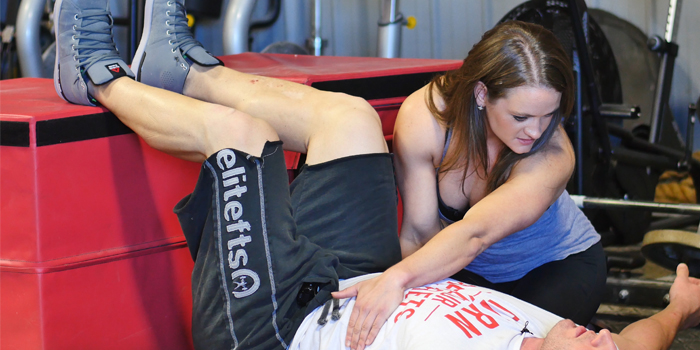
“Pushing through fear is less frightening than living with the underlying fear that comes from a feeling of helplessness.” —Susan Jeffers
I read this quote from Feel the Fear...and Do It Anyway shortly before everything with the coronavirus put most of our world into a halt. It struck a chord with me at the time because in the past year, I’ve thrown myself into multiple processes that scare the crap out of me—processes I chose because I was tired of what was in my lunchbox. It seems even more fitting now, a time when most of us are living on a pendulum of fear and hopelessness, with “anger” being somewhere in the middle.
Most of my job as a physical therapist and coach revolves around a technical skill and a body of knowledge, but so much of working with people through injury, training, or nutrition has more to do with mindset and behaviors.
RECENT: Top 6 Mistakes Powerlifters Make Health-Wise
Training, for so many of us, is our certainty. It’s our escape and maybe even the only time you feel in control during the day. Having that portion of our lives removed, for so many of us, has left us staring down demons that the iron usually hides. I’ve lost two friends in the past month, and I’ve had countless athletes reach out to me for help with structuring where to go. I’m hoping that by the time this article gets published, things are on their way back to normal, but in the meantime (and even if they are), there are a few key tools I’ve given my clients to help them to mentally move forward (not just survive) when we feel a lack of control. These are especially relevant now, but these are processes that I use with many of my injured athletes or general coaching/nutrition clients.
1. Name Your Barriers
When confusion or a lack of routine feels like “chaos” and all we feel is the net effect of something we love being taken away, it’s easy to feel a loss of control. We know there are reasons we can’t do what we’d like to do, or even a modified version of it, but the thought of “can’t” is self-limiting and often self-fulfilling. Naming your barriers is a bit like when, in a movie, whatever monster is chasing the main characters comes to light. Things are always scarier and we feel less control when we’re battling what we can’t see. Naming the issues at hand (maybe it’s, “I don’t even have access to bands right now”) takes the swirl of chaos and boils it down to key points. My challenge for my clients is always to follow up naming the barrier with a but statement. “I don’t have access to bands, but I have milk jugs.” “I can’t load anything heavy, but I can still train to failure, or close, with other weight.” It shifts the power away from the situation and back to you. It’s not ideal, and I’m not saying that it solves everything, but the feeling of control in a less-than-ideal situation makes the entire plate more palatable.
2. Identify Sub-Goals and Focus On What You Can Control
These might be fitness related, or they may not be at all. I have one client who, when challenged with this, decided that she had three specific relationships that she wanted to nurture. She dedicated a portion of what would have been her training time (say, 30 minutes) to nurturing those relationships. I have another client who has always wanted to be able to do a pistol squat (again, this is measurable and specific), so we broke down his mobility and stability challenges and built him a progression. This shifts the power away from what barriers you might have and gives you something active to work toward. Skills you hope to acquire need to be broken down into actions, practices, or subcomponents, and often these subcomponents will give you a new “goal” each week.
3. Limit your Influences
Information overload is a thing, as is overexposure to what other people are doing. Many of us naturally start to compare one life with another, maybe ours to someone else’s, which has the potential to rob us of experiencing and celebrating the success we have. The thing is, everyone chooses his or her goals to celebrate, post, talk about, whatever, because they are part of what he or she might feel is his or her purpose, what’s important to him or her, and how he or she self-identifies. Their purpose is not your purpose… and trying to live or press into someone else’s “thing” may very well rob you of yours. So many people are hurting because they’re comparing themselves with someone with an entirely different life circumstance, calling, or belief system. Remove that temptation. Really. You’ll be happier with your own progress (which via steps 1 and 2, you’ve identified) if you aren’t constantly looking for the next best way to move forward.
4. Build your A-Team
Your “A-Team” should be people who support and understand your vision, call out your strengths, push you through your growth opportunities, and are more interested in your success than being your “yes” men and not calling you to greater along the way. This is a small circle for most of us. For me, it’s my husband, my best friend (who is not involved in fitness whatsoever but reminds me who I am when I feel lost), and a few of my elitefts teammates who I know can handle raw honesty in the high and low moments. These are people who should not only believe in the direction in which you want to go but also actively drive with you in that direction. These are not passive passengers. They’re navigating with you. Keeping your A-Team close will help you to limit your influences (because let’s face it, everyone wants to have a voice and an opinion) to the people whose words actually carry weight.
5. Identify and Snag Low-Hanging Fruit
Find wins for yourself. Most of you guys reading this probably have one or more movements that you know you’re terrible at, one or more orthopedic-based injuries you know you need to give some TLC to, or glaring weaknesses that need to be addressed. Most of these things don’t require heavy weights, a barbell, or a plethora of equipment. Some simple bands or light weights (like dog food bags) will do the trick. If you can actively work on improving these things, there’s a huge sense of accomplishment that follows. Action precedes motivation. As you improve, you’ll continue to press into the things that matter to you.
None of this is rocket science, but what these practices allow you to do is to regain control and hopefully remove some of the fear and chaos around you.










